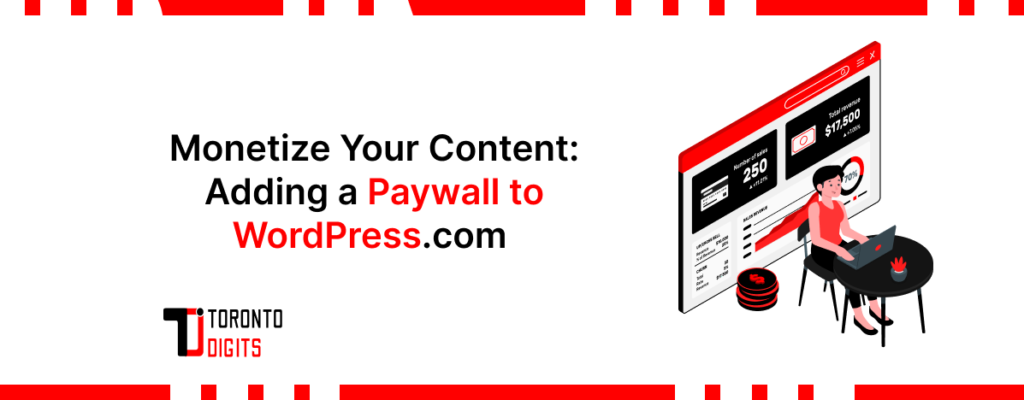Are you tired of pouring your creativity into captivating content, only to find your financial gains lacking? You’re not alone. In today’s digital landscape, content creators face constant challenges in monetizing their work online. However, there’s a solution gaining traction: paywalls. Paywalls and memberships often go hand in hand, offering creators multiple revenue streams.
While often associated with major news organizations, paywalls can be surprisingly effective for niche creators and bloggers on platforms like WordPress.com. Retainers might involve membership or paywall setups, depending on the content model you choose. Paywall content requires engagement tracking to understand what drives subscriptions and retention. Social media drives traffic to paywall content, making it an essential promotional tool. SEO improves visibility for paywalled content, helping new audiences discover your work.
If you’re ready to unlock the full potential of your content and generate sustainable income, read on!
Understanding Paywalls: What Are They and Why Use Them?
Before delving into implementation, it’s crucial to understand what paywalls are and how they can benefit content creators. In essence, a paywall is a digital barrier that restricts access to certain content, requiring users to pay a fee or subscribe to gain entry. Paywalls come in various forms, including metered, freemium, and membership models, each with its own set of advantages and considerations.
Metered paywalls
Metered paywalls offer a limited amount of free content before prompting users to subscribe. This approach is effective for enticing readers with a taste of your content while incentivizing them to invest in access to premium material.
Freemium Paywalls
Freemium paywalls provide basic content for free but reserve premium features, exclusive content, or advanced functionality for paying subscribers. This model strikes a balance between accessibility and monetization, offering additional value to those willing to pay.
Membership Paywalls
Membership paywalls grant subscribers access to an entire library of content, a community, or exclusive perks for a recurring fee. This model fosters a sense of belonging and loyalty among subscribers, creating a sustainable revenue stream for content creators.
The decision to implement a paywall should be based on factors such as your content type, audience demographics, and revenue goals. While paywalls offer a promising avenue for monetization, it’s essential to consider user experience, accessibility, and legal compliance when designing your strategy.
Adding a Paywall to WordPress.com: Navigating Your Options
WordPress.com offers several avenues for implementing a paywall, catering to creators of all backgrounds and skill levels. While the platform may have limitations compared to self-hosted WordPress sites, there are still viable options for monetizing your content.
WordPress.com Business Plan
Upgrading to the Business plan unlocks features such as paid subscriptions, limited-access content, and custom domain integration, providing a straightforward paywall solution within the platform’s ecosystem.
External Integrations
Leveraging third-party services like MemberPress, Stripe, or Gumroad allows for more flexibility and customization when implementing a paywall on WordPress.com. These integrations offer advanced features such as customizable subscription tiers, payment processing, and analytics tracking.
Creative Strategies
In addition to traditional paywalls, content creators can explore alternative monetization methods, such as offering exclusive content bundles, tiered donation models, or early access perks. These strategies enable creators to monetize their content while maintaining flexibility and control over their offerings.
When choosing a paywall solution for your WordPress.com site, consider factors such as ease of integration, cost, scalability, and audience preferences. Evaluate each option carefully to ensure it aligns with your content strategy and revenue objectives.
Implementing Your Paywalled Strategy: A Step-by-Step Guide
Once you’ve chosen a paywall solution for your WordPress.com site, it’s time to put your plan into action. Follow these steps to implement your paywalled strategy effectively:
Step 1: Plan Your Content Strategy
Determine which content you want to monetize and how you’ll structure your offerings behind the paywall. Consider factors such as content frequency, exclusivity, and value proposition.
Step 2: Choose Your Paywall Solution
Select the paywall method that best aligns with your content strategy, audience preferences, and technical capabilities. Whether opting for the WordPress.com Business plan, third-party integrations, or creative strategies, ensure it meets your monetization goals.
Step 3: Set Up Your Paywall
Follow the instructions provided by your chosen paywall solution to set up your account, configure payment options, and integrate the paywall with your WordPress.com site. Customize the paywall settings to reflect your branding, pricing, and content access rules.
Step 4: Promote Your Paywalled Content
Once your paywall is live, promote your premium offerings to your audience through various channels, such as social media, email marketing, and content marketing. Highlight the benefits of subscribing, exclusive features, and the value proposition to entice potential subscribers.
Step 5: Monitor and Optimize
Continuously monitor your paywall performance, track key metrics such as subscription rates, churn, and revenue, and iterate based on insights gathered. Experiment with pricing, content offerings, and promotional strategies to optimize your paywall strategy for maximum effectiveness.
By following these steps, you can successfully implement a paywall on your WordPress.com site and monetize your content effectively.
Also Read: The Definitive Guide to WordPress Security
Optimizing Your Paywall Strategy for Success
While implementing a paywall is a significant step towards monetizing your content, success hinges on several factors beyond the technical implementation. To maximize your paywall’s effectiveness and generate sustainable revenue, consider the following tips:
Focus on Content Quality
Invest in creating high-quality, valuable content that resonates with your audience’s interests and needs. Your premium offerings should provide unique insights, in-depth analysis, or exclusive access to content that cannot be found elsewhere.
Communicate Value Proposition
Clearly articulate the benefits of subscribing to your paywalled content, emphasizing the exclusive features, benefits, and value proposition that subscribers will receive. Highlight what sets your premium offerings apart from free alternatives and why they’re worth paying for.
Foster Community Engagement
Build a sense of community among your paying subscribers by offering exclusive perks, such as member-only forums, Q&A sessions, or live events. Encourage interaction and feedback to create a valuable and engaging experience for subscribers.
Promote Strategically
Develop a comprehensive marketing strategy to promote your paywalled content to your target audience. Utilize various channels, such as social media, email marketing, content partnerships, and influencer collaborations, to reach potential subscribers and drive conversions.
Continuously Iterate and Improve
Paywalling is an ongoing process that requires experimentation, analysis, and optimization to achieve success. Continuously monitor key metrics, gather feedback from subscribers, and iterate on your paywall strategy to improve performance and maximize revenue.
Conclusion
Adding a paywall to your WordPress.com site offers a powerful way to monetize your content and generate sustainable revenue. By understanding the different paywall models, navigating your options on WordPress.com, and implementing a strategic paywall strategy, you can effectively monetize your content and create a thriving business online.
Remember to focus on providing value to your audience, communicate your value proposition effectively, and continuously optimize your paywall strategy for success. With dedication, creativity, and strategic execution, you can unlock the earning potential of your content and build a profitable online business with WordPress.com.




